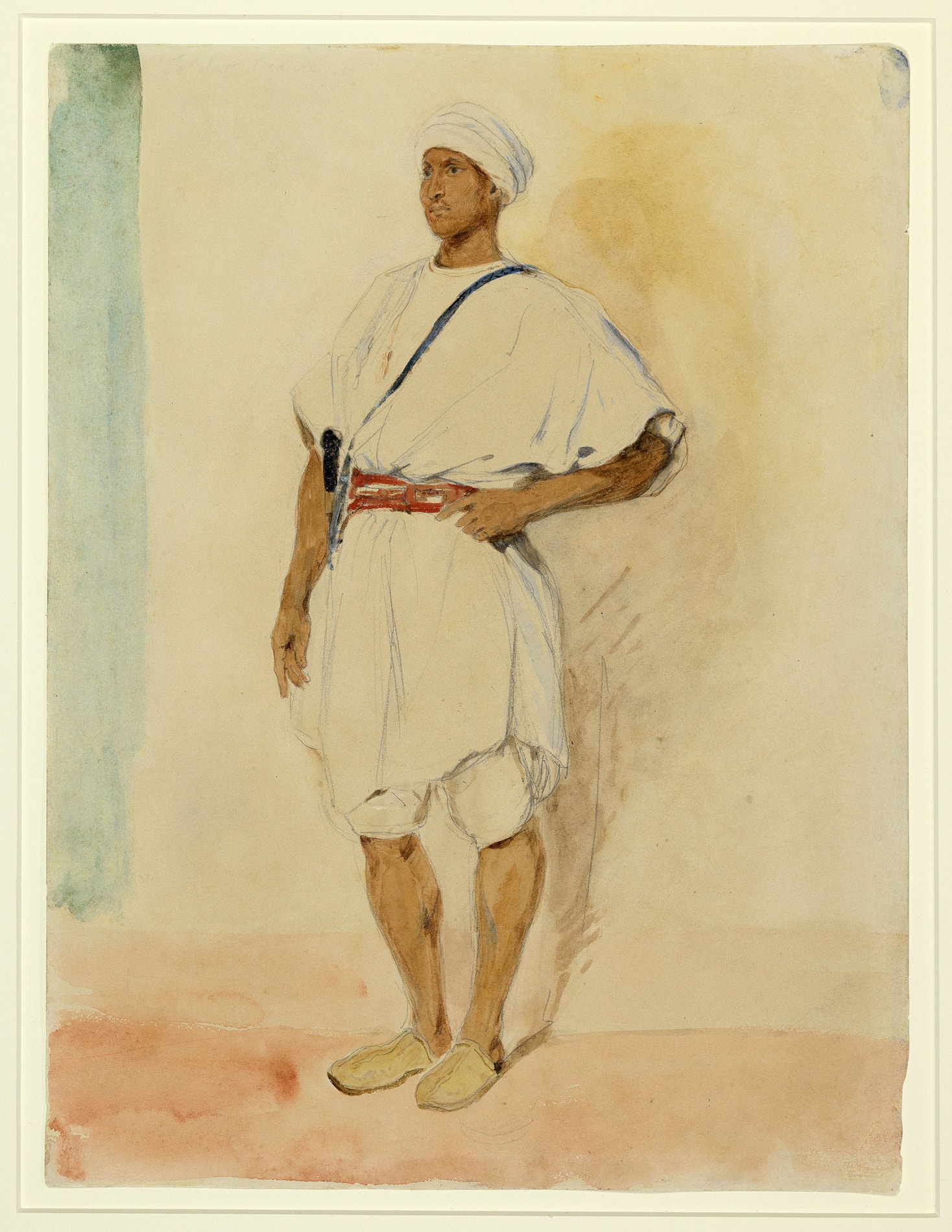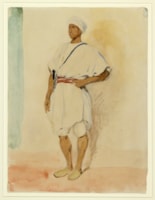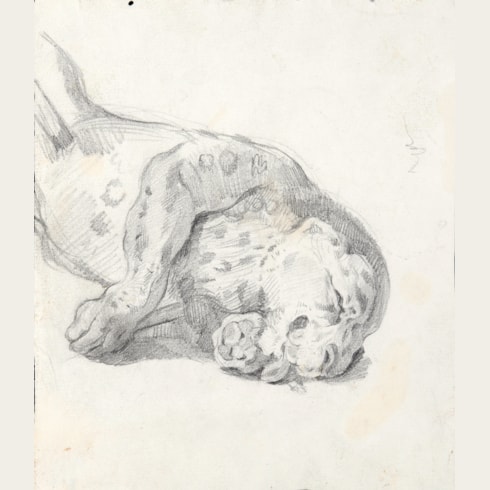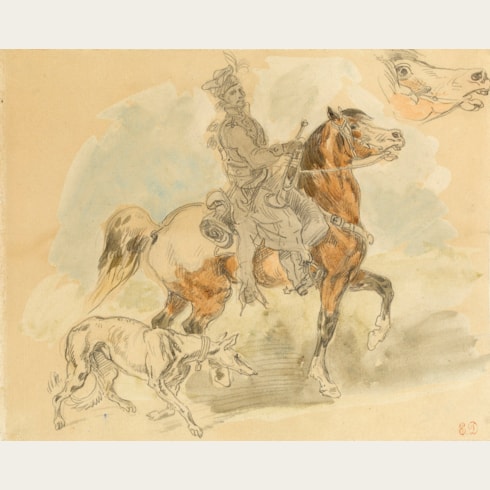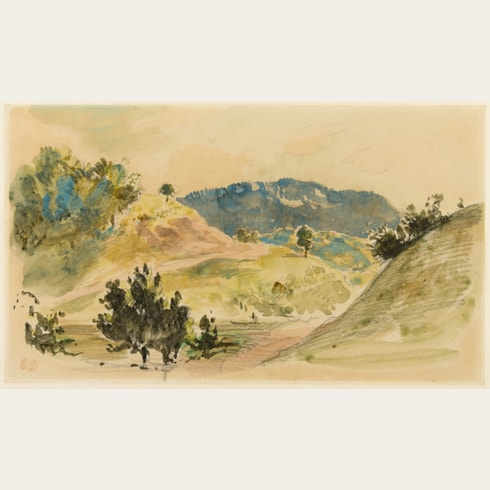Eugène DELACROIX
(Charenton-Saint Maurice 1798 - Paris 1863)
A Standing Moroccan Man
Sold
Watercolour, over a pencil underdrawing.
323 x 242 mm. (12 3/4 x 9 1/2 in.)
323 x 242 mm. (12 3/4 x 9 1/2 in.)
In the first half of 1832, Eugène Delacroix spent six months in North Africa as part of a French diplomatic mission to Morocco. The artist filled at least seven sketchbooks with pencil and watercolour drawings of the people he saw and the places he visited, often adding descriptive texts to his drawings. The numerous studies the artist made in Morocco provided inspiration for paintings throughout the remainder of his career. Indeed, the few months that he spent in Morocco in 1832 were to be of lasting importance for Delacroix’s artistic development.
Delacroix kept his Moroccan sketchbooks in his studio until his death. Four of these sketchbooks have remained intact - three in the Louvre and one in the Musée Condé in Chantilly – while the others have been broken up, with the individual drawings, of which the present sheet is one of the finest, sold and dispersed. The drawings and sketches Delacroix brought back from Morocco amounted to almost a sixth of the total of the works on paper sold at the posthumous sale of the contents of his studio in Paris in 1864. These works were aptly described by Philippe Burty, in the preface to the auction catalogue, as a ‘series of unique studies, both brilliant and scrupulously precise, of styles and costumes, of events and landscapes, notes that he made daily either against the pommel of his saddle or in an Arab’s tent, in the streets of Meknes or in Abd al-Rahman’s palace...’ It is thought that Delacroix may have intended to eventually publish an illustrated account of his journey to a country that few Europeans had visited, but none ever appeared.
Among the facets of Moroccan life and culture that particularly interested Delacroix were local costumes and dress. As he noted in a letter from Tangier in February 1832, a month after his arrival in Morocco, ‘The people of this country are a people apart; in many ways they are different from other Mohammedan peoples. Their dress is quite uniform and very simple, and yet the various ways of arranging it confer on it a kind of beauty and nobility that leaves one speechless. I intend to bring back enough sketches to give an idea of how these gentlemen are dressed.’ Apart from making numerous drawings of Arab costumes, Delacroix also purchased several examples to bring back with him to Paris.
Arlette Sérullaz has tentatively identified the subject of this drawing as one Caddour, the guardian of the French consulate in Tangiers. As one recent scholar has noted, this young man has ‘something of that haughty refinement that Delacroix saw and admired among the Arabs.’ Certainly this Moroccan youth - with his white tunic, turban and knee-length trousers, red belt, yellow slippers and a dagger attached by a plaited cord - must have been someone whom Delacroix was able to study at length, as he appears in a handful of other drawings and watercolours by the artist, three of which were in the posthumous studio sale of 1864. These include a watercolour now in the collection of the Baltimore Museum of Art, showing two studies of the same young man, as well as a smaller watercolour of the same figure, but seen from the back, in a private collection in London. The fact that Delacroix produced several drawings of this young Moroccan, including a portrait study, would suggest that the artist intended to use this figure in a painting, but no related work is known today.
A line study for the present sheet, drawn in ink alone, was once part of an album of Moroccan drawings and watercolours by Delacroix belonging to the collector Baron Joseph Vitta (1860-1942), and is today in the Bibliothèque Nationale in Paris.
Delacroix kept his Moroccan sketchbooks in his studio until his death. Four of these sketchbooks have remained intact - three in the Louvre and one in the Musée Condé in Chantilly – while the others have been broken up, with the individual drawings, of which the present sheet is one of the finest, sold and dispersed. The drawings and sketches Delacroix brought back from Morocco amounted to almost a sixth of the total of the works on paper sold at the posthumous sale of the contents of his studio in Paris in 1864. These works were aptly described by Philippe Burty, in the preface to the auction catalogue, as a ‘series of unique studies, both brilliant and scrupulously precise, of styles and costumes, of events and landscapes, notes that he made daily either against the pommel of his saddle or in an Arab’s tent, in the streets of Meknes or in Abd al-Rahman’s palace...’ It is thought that Delacroix may have intended to eventually publish an illustrated account of his journey to a country that few Europeans had visited, but none ever appeared.
Among the facets of Moroccan life and culture that particularly interested Delacroix were local costumes and dress. As he noted in a letter from Tangier in February 1832, a month after his arrival in Morocco, ‘The people of this country are a people apart; in many ways they are different from other Mohammedan peoples. Their dress is quite uniform and very simple, and yet the various ways of arranging it confer on it a kind of beauty and nobility that leaves one speechless. I intend to bring back enough sketches to give an idea of how these gentlemen are dressed.’ Apart from making numerous drawings of Arab costumes, Delacroix also purchased several examples to bring back with him to Paris.
Arlette Sérullaz has tentatively identified the subject of this drawing as one Caddour, the guardian of the French consulate in Tangiers. As one recent scholar has noted, this young man has ‘something of that haughty refinement that Delacroix saw and admired among the Arabs.’ Certainly this Moroccan youth - with his white tunic, turban and knee-length trousers, red belt, yellow slippers and a dagger attached by a plaited cord - must have been someone whom Delacroix was able to study at length, as he appears in a handful of other drawings and watercolours by the artist, three of which were in the posthumous studio sale of 1864. These include a watercolour now in the collection of the Baltimore Museum of Art, showing two studies of the same young man, as well as a smaller watercolour of the same figure, but seen from the back, in a private collection in London. The fact that Delacroix produced several drawings of this young Moroccan, including a portrait study, would suggest that the artist intended to use this figure in a painting, but no related work is known today.
A line study for the present sheet, drawn in ink alone, was once part of an album of Moroccan drawings and watercolours by Delacroix belonging to the collector Baron Joseph Vitta (1860-1942), and is today in the Bibliothèque Nationale in Paris.
Eugène Delacroix has long been recognized as one of the finest draughtsmen of the 19th century in France. Adept in a variety of techniques – notably pen, pencil, watercolour, charcoal and pastel - he produced a large and diverse number of drawings of all types. As a modern scholar has noted, ‘For their number, variety and importance he attached to them, drawings are an essential, if not fundamental part of Delacroix’s oeuvre…they represent the most faithful testimonies of the man and the artist with his foibles but his greatness as well.’
However, Delacroix’s output as a draughtsman remained almost completely unknown and unseen by scholars, collectors and connoisseurs until the posthumous auction of the contents of his studio held in February 1864, six months after the artist’s death, which included some six thousand drawings in 430 lots. The sale included not only preparatory compositional sketches and figure studies for Delacroix’s paintings and public commissions, but a myriad variety of drawings by the artist, including studies of wild animals, landscapes, copies after the work of earlier masters, costume studies, scenes from literature, still life subjects and the occasional portrait, as well as finished pastels. In the words of the Delacroix scholar Lee Johnson, ‘It came as a surprise to many that an artist who had been so consistently criticized throughout his career for incompetence as a draughtsman and laxity in composition was revealed by the many hundreds of graphic works, the fifty-five sketchbooks, and scores of oil sketches at his sale to have been a draughtsman of extraordinary versatility and one who went to infinite pains to elaborate the compositions of his paintings through preliminary studies of many kinds, from the inchoate scribbles of an idea in germ, to more articulate designs, to detailed drawings of pose and gesture.’
The largest single collection of drawings by Delacroix, numbering almost three thousand individual sheets and twenty-three sketchbooks, is today in the Louvre.
Provenance
Walter Pach, New York
Thence by descent until 2011
Sale (‘Property from the Collection of the Late Walter Pach’), London, Christie’s, 5 July 2011, lot 103.
Literature
Walter Pach, ‘Delacroix Speaks for Himself’, Art News, 1-14 November 1944, illustrated p.10
Walter Pach, ed., The Journal of Eugene Delacroix, New York, 1948, illustrated in colour between pp.64 and 65
Agnes Mongan, ‘Souvenirs of Delacroix’s Journey to Morocco in American Collections’, Master Drawings, Summer 1963, p.27.
Walter Pach, ed., The Journal of Eugene Delacroix, New York, 1948, illustrated in colour between pp.64 and 65
Agnes Mongan, ‘Souvenirs of Delacroix’s Journey to Morocco in American Collections’, Master Drawings, Summer 1963, p.27.
Exhibition
New York, Wildenstein & Co., Eugene Delacroix 1798-1863; Loan exhibition in aid of the Quaker Emergency Service, 1944.

